When you think about the Marvel Universe, you think Spider-Man and the X-Men, sure – but Iron Man and Hulk and Thor and Captain America and the Fantastic Four and all the rest too. DC has older properties (Wonder Woman, born in 1942; Green Lantern, from 1940; the Flash, who debuted the same year), but beyond that the list of marquee names tails off. Not that it matters too much, of course; not when they have the two most important of them all.
Superman and Batman aren’t just household names, but the foundations upon which an entire genre – and, indeed, the whole comic book industry – has been built. They’re light versus dark, optimism contrasted with obsession, power unlimited against the need to make the very most of what you’ve got. And when the pair of them come together, it’s the most compelling, most uneasy, most dynamic alliance in the comics. One that the film studios are hoping to capitalise on this summer in Batman Vs Superman.
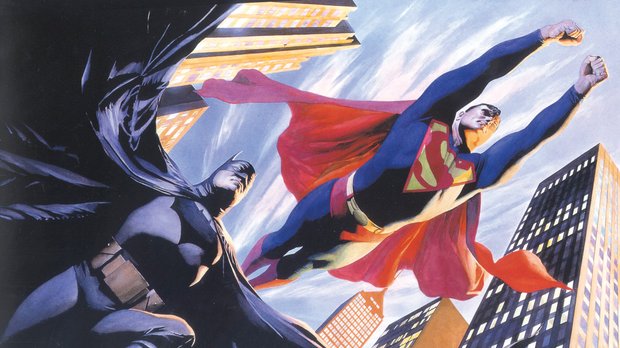
Superman was first created by two young Cleveland residents, Jerry Siegel and Joe Shuster, while at high school, but only appeared in print a number of years later, when National Allied Publishing (precursor to DC) was casting around for a lead feature for its new Action Comics title. Against the odds, Siegel and Shuster’s much-rejected creation finally got his chance – and ran (or perhaps flew) with it. It was 1938, and Superman was an immediate hit, earning a second, self-named title the following year.
And then, of course, within the next 12 months we’d seen the debut of his biggest friend and rival, Batman, too. Millionaire playboy Bruce Wayne’s dark, vengeful alter-ego first appeared in Detective Comics #27, a grim, street-level crime-buster with no special powers but a dramatic costume and striking deductive skills. He, too, quickly caught the public imagination, and by 1940 also had his own dedicated title, Batman, to run alongside Detective. The modern superhero was born.
As with all the other superheroes, Batman had, of course, been part-inspired by the success of Superman the previous year – but he had other things going for him too: a distinctive silhouette, for one, and a very different mood, influenced by crime stories and the pulps. Visually, he was a grab-bag of bits and pieces from films The Bat-Whisperers and The Mark Of Zorro, Bela Lugosi’s Dracula and the flying machine sketches of Leonardo da Vinci. Put into a metaphorical blender, this lot led artist Bob Kane and writer Bill Finger towards a moody grey-and-black costume design with sharp horns, pupil-less white eyes and a scallop-edged cape; there would soon be pointed blades on Batman’s gloves too.

Indeed, there were sharp, pointy triangles everywhere on this guy, and that soon extended to his car, his plane, his throwing weapons – in silhouette, only Superman’s stance would distinguish him from most other superheroes, but this guy was unmistakable however you drew him. In time, both strips would learn from each other – Batman would lend Superman the idea of powerful iconography, while Superman would give Batman the model for an extended family of linked characters. But for the first few years the two heroes were different beasts indeed.
And the world in which they existed was very different to what we know now too. Back in the early ’40s, comic books were generally fat, cheapish anthologies. Inside each book, the different heroes would occupy their own distinct little worlds, and crossovers between any two of them were virtually unheard of – the modern team-up was decades hence. Indeed, so rare were team-ups that – apart from on numerous covers and the odd single-panel cameo inside, as in All-Star Comics #7, published in late 1941 – Superman and Batman wouldn’t actually cross paths for years. Not until Superman #76 (May-June 1952), in fact, the pair having at this point been household names for approaching 15 years.
Get sneak previews, exclusive competitions and details of special events each month!
By modern standards this is ridiculous, of course. But crossovers simply weren’t part of a creator’s regular tool bag at the time. The earliest versions of the pair had occupied such different spaces – Superman’s smiling and brightly coloured; Batman’s introverted and spooky – that it had been hard to see how they’d slot together at all. And anyway, surely their powers were of such different magnitudes as to make a team-up laughable? Wouldn’t the Dark Knight find himself more or less redundant if the two were ever paired?
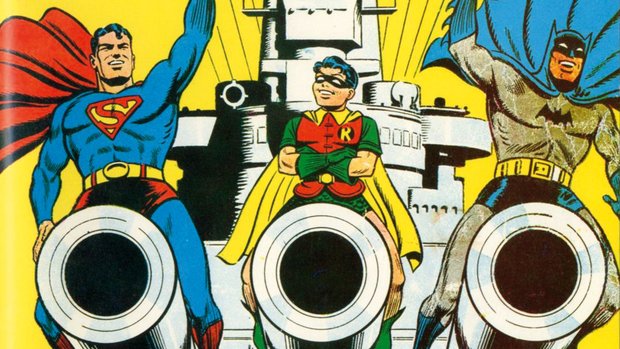
Not so, as it turned out. But the first proof of this didn’t come from the comics. Batman and Robin (a 1940 addition) actually met Superman on the radio long before they encountered each other on the page. The Dynamic Duo guest-starred repeatedly on the smash hit The Adventures Of Superman radio show that had been turning the Man of Steel into a household name since the dawn of the ’40s, and though Bruce and Dick came late to the party – first cropping up in 1945 – they made quite the impact, at times dominating events as Superman disappeared, perhaps captured or weakened by green Kryptonite or simply otherwise engaged. (Actually, what was really happening was that Superman actor Bud Collyer needed a holiday occasionally, and these two made for acceptable stand-ins.)
Part novelty, part temporary replacement lead, and part try-out for a possible Caped Crusader radio show (which never happened), Batman’s appearances here showed one effective approach to teaming two such different heroes – let them spend as little time together as possible. Though meetings between any two superheroes were rare at first, in time they did start to happen – most notably in 1940, when the first real superteam was established in the pages of National’s All-Star Comics. The Justice Society of America, as they were known, was another immediate sensation.
Not that their adventures would do much for audiences today. Superman and Batman (and soon even the Flash and Green Lantern, heroes on the next rung down) were sidelined, defined as honorary JSA members only, leaving the coast clear for the series to push the lesser-known likes of Hawkman, Doctor Fate and the Spectre. Initially, the good guys would meet at the beginning and the end of each issue only, while each hero’s own creative team would tell a solo story in the middle explaining how their particular good guy battled an aspect of some larger overall menace.
"On a light-hearted ocean cruise, we see Bruce Wayne and Clark Kent forced to share a cabin."
Later, thinner issues would force more interactive storylines, but it couldn’t last long; times were hard, and All-Star (and, with it, the JSA) disappeared in 1951, the book transformed into a Western title. The permanent superhero team-up had been just one more victim of the entire genre’s sudden decline, and the line-wide DC cull that followed.
But years later, when the concept returned in 1960 – now called Justice League of America and built around all of DC’s biggest guns – it did include Wonder Woman, Green Lantern and the Flash, while Superman and Batman took centre stage. And ever since, through name changes and line-up shifts, DC’s premier superteam has spun around the core alliance (and philosophical conflict) at its heart: the relationship between Bruce Wayne and Clark Kent. (Even when one or both has been missing from the roster – as in the mid-’80s light comedy reworking of the team by Keith Giffen and others – the shadow of those absent has loomed large.) But the Justice League is another story, and by the time it appeared, Batman and Superman had already enjoyed a long history fighting side by side.
It was with the collapse of All-Star Comics in the early ’50s – where the two heroes could have conceivably turned up every issue, but in actual fact almost never did – that DC decided the time was right to do the obvious thing and put its marquee names together, initially in sporadic toe-in-the-water fashion, but eventually as a permanent fixture. Superman #76 came out the year after All-Star ended, spotlighting an Edmond Hamilton/Curt Swan tale called “The Mightiest Team on Earth!” On the cover we saw Lois Lane caught in a fire. Inside, on a light-hearted ocean cruise, we see Bruce Wayne and Clark Kent forced to share a cabin, both quickly sussing out the other’s secret; misunderstandings and confusion ensue.
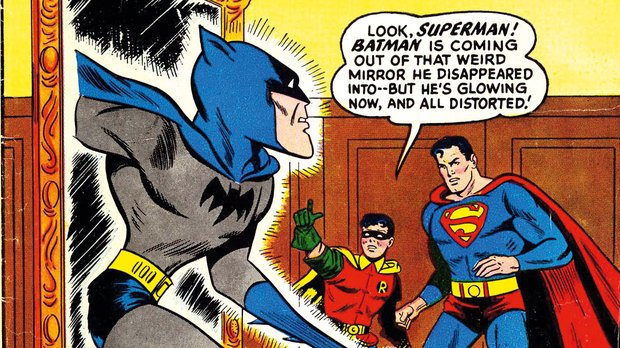
The tale basically worked as an early dry-run for the new, shorter, cheaper incarnation of World’s Finest Comics that began in 1954 – and now a combination of space constraints and pragmatism combined the Batman and Superman stories into a single feature for the first time. The original writer assigned the job – Alvin Schwartz, who’d penned the first Bizarro story – described it as like “mixing ice cream and mustard” and soon quit; Edmond Hamilton was happy to take over.
World’s Finest had originally begun in 1941 as a fat quarterly featuring a variety of strips, some superhero, some not. Red, White and Blue were three young soldier buddies, and Hop Harrigan a daredevil pilot – but Zatara the magician was here also, and Johnny Thunder with his Thunderbolt. And shoulder-to-shoulder on the covers of many issues: Batman and Superman, though they never shared adventures inside.
The pair had been first drawn together for the cover of the bumper-sized New York World’s Fair Comics #2 in 1940 – bizarrely, it wasn’t Kane or Shuster or any of the other big names who got the gig, but the relatively lowly Jack Burnley, best known for his patriotic Superman covers. The book’s title would soon mutate into World’s Best Comics, then World’s Finest an issue later.
The regular Batman-meets-Superman covers, however, had dual functions – they established the two leading DC heroes as pals, and they dragged the Dark Knight Detective away from eternal Gotham gloom and into something approaching Superman’s sunny world. Thus we had a grinning Batman playing softball with an equally cheery Robin and Superman on the cover of #3, or the trio selling “Sink the Japanazis” war bonds on #8, or Supes pulling a giddy Dynamic Duo at super-speed in a hand-drawn cart on #17. (Most hilarious: the three of them riding the giant, phallic guns of a US battleship on #7.)
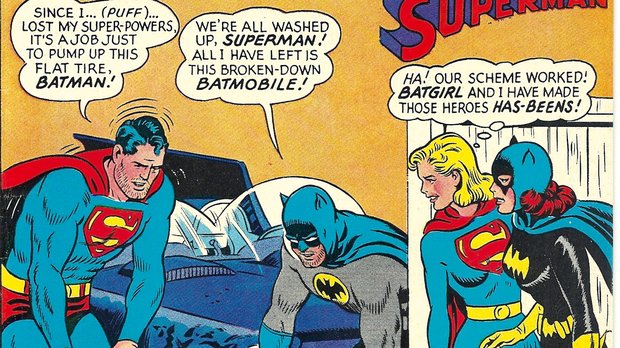
But all of this changed in 1954 when – now monthly – one of the many reductions in page count saw the Superman and Batman strips inside combined into one feature from #71 onwards, a status quo that saw the title through to the start of the ’70s. Now, finally, the two heroes were working together on a regular basis – but how would they fare?
The answer was: surprisingly well. Yes, there was still the obvious power mismatch to deal with – but other than that the strips proved remarkably compatible. This was a largely happy Batman who’d over the years lost much of his original Kane/Finger gothic doom, and was now cheerily meeting aliens and travelling though time in his own title. Along the way he’d picked up exotic gadgets and vehicles galore, and it had been just a small step from there to trips abroad and complicated disguises, and then again to time travel and weird transformations (the Merman Batman! The Zebra Batman!) and creatures from Planetoid X.
On the new World’s Finest, incumbent Bat-artist Dick Sprang and leading Superman penciller Curt Swan sometimes collaborated, and the book became a merry mix. Oh sure, Superman was by far the more popular character at the time, and the plots often reflected the gimmick-driven style of his books – but Batman got more than his fair crack. Certainly, his supporting cast tended to dominate (blame Batman editor Jack Schiff, who also looked after this title) and Bats was prominent in each tale, usually using his detective skills to pull his weight. (Superman fans sometimes cried foul; their guy was often depicted as dumb brawn to Batman’s brains, they said, and they had a point.)
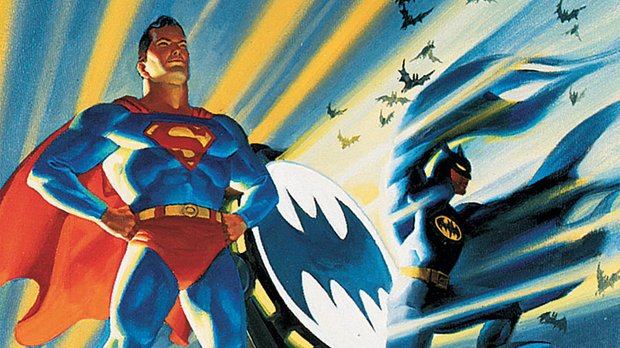
While, in general, the Jack Schiff-led Bat-line had become cruder and uglier than the Superman titles – especially so when Bob Kane and his studio returned to the title, the stiffness always present in the Batman co-creator’s work seeming to have got worse over the years – there was always imagination there, and a sense of humour. And this was especially true of World’s Finest, Schiff’s personal favourite book.
For one thing, he had perhaps the period’s best team on it. There were scripts by Edmond Hamilton, who’d married SF novelist and screenwriter Leigh Brackett and was a major space opera author in his own right (Hamilton had written the Interstellar Patrol and The Star Kings novel sequences, as well as the Captain Future young adult franchise). At DC Hamilton contributed many great Superman tales, but World’s Finest saw much of his best work. And he was lucky in his artist too: he got Dick Sprang, one of the titans of the Golden Age, and co-creator of both the Riddler and “The Batmobile of 1950”.
Sprang generally drew small, blocky figures in a deceptively stiff and child-like style, but his faces were expressive, his layouts fluid and dynamic, his lines clean, his tales well-paced and his background details heaving with wit, charm, bold design and unexpected flourishes. A modern Batman reader might find it all a bit mental – should their hero really be travelling to different planets and time zones quite so easily? – but it made perfect sense at the time, and had charm to spare.
The fine Jim Mooney would become the regular artist on World’s Finest in time, though he found it hard to reproduce the same sense of fun, and the remaining non-superhero back-up strips would fall away, to be replaced by the likes of Aquaman. Soon World’s Finest was a sort of ark, containing the superheroes (barring Wonder Woman) who’d survived the ’50s.
It was at this point, with the title flipped from the smaller Batman stable to the Superman family of books, as led by formidable-cum-petrifying editor Mort Weisinger, that World’s Finest enters its glory years, more inventive and livelier than most of the solo Super and Bat-efforts of the era – sporadically, it was the best comic on the stands.
And throughout, Bruce and Clark were presented as two peas in a pod: one “imaginary” tale has the young Bruce Wayne also adopted by the Kents, making the two heroes brothers, while Jimmy Olsen would often team up with Robin, or Supergirl with Batgirl – if there were parallels to be found, Weisinger would run with them. Clever plotting was king here, rather than in-depth character examination or enduring inter-hero conflict.
Occasionally modernity would impose itself on this cosy, old-fashioned world – like when Neal Adams pencilled a couple of issues in the late ’60s, which must have come as a slap in the face to more insular readers – but by that point things had gone pretty stale. Batman had briefly been given the heave-ho, turning the title into an ongoing Superman team-up book – his version of The Brave And The Bold – and though Bruce made a permanent return a couple of years later, the whole “World’s Finest” concept seemed well past its sell-by date. When it was replaced in the mid-’80s by a new Superman title, few mourned.
In its various revivals, however, World’s Finest has come closer to living up to its name. The high-end, out-of-continuity and utterly gorgeous 1990 miniseries, written by Dave Gibbons with art by Steve Rude, contrasted the mythologies nicely, for instance – Lex Luther goes to Gotham City, the Joker to Metropolis, and we get strong contrasts between the villains, the home-towns and the supporting casts. It provided a good model for many meetings between the two characters since. All the while World’s Finest was running, Batman and Superman would constantly run into each other in the pages of their respective strips too, and usually they were depicted as the best of buddies.
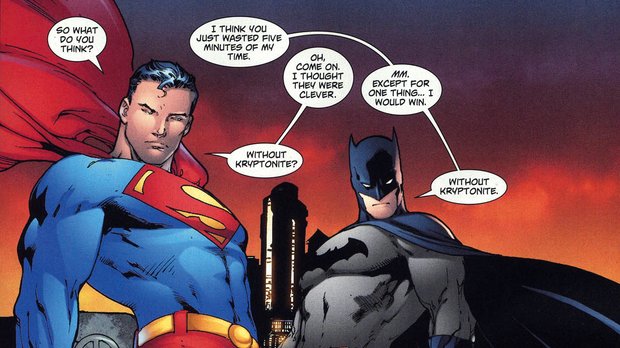
When Hamilton and lead Superman artist Curt Swan collaborated on adventures for Superman inside the Bottle City of Kandor – a lost chunk of old Krypton, complete with a thriving population of six million, shrunk until it was small enough to sit on a desk – they soon found a way to compensate for Superman’s lack of powers in his home environment. By 1968 Superman could temporarily shrink small enough to visit the Bottle City, and he and his young pal Jimmy Olsen would regularly team up to become its very own Dynamic Duo, Nightwing and Flamebird. Named after famous Kryptonian beasts – there being no bats or robins on Krypton – they had a “Nightcave”, drove a “Nightmobile”, walked a “Nighthound” and flew into battle using jet-belts. (At one point the real Batman and Robin would even come to visit, similarly shrunk, and the four naturally teamed up.)
And the compliment would be returned years later when, flailing around for a new secret identity after growing too big for Robin’s short-shorts, Dick Grayson would take on a new name and costume – Nightwing – in honour of those adventures. (In post Crisis-continuity, with Kandor eliminated from history, the name is explained as that of a legendary old Kryptonian crime-fighter who Superman once told Dick about.)
Indeed, it seems that whenever there’s a major turning point for one character, the other usually turns up. So, in the low-key 20th anniversary issue of Superman’s adventures – Action #241, from 1958 – we were first introduced to the Fortress of Solitude, sure, but it’s our hero putting his feet up, doing some painting (thanks to his telescopic vision it’s a Martian landscape) and goofing around with pal Batman that we remember best.
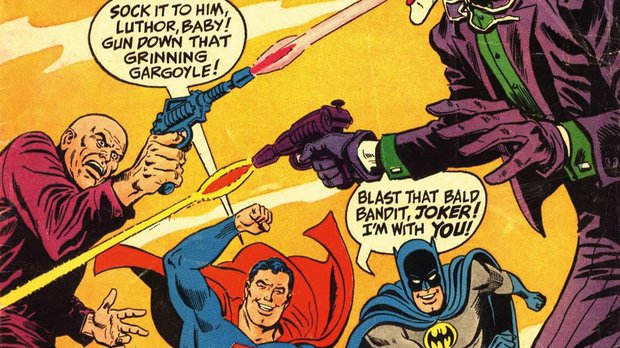
And so it’s been, their lives in parallel. For every Jimmy, there’s a Robin; for every Batcave, there’s a Fortress of Solitude; for every Krypto, an Ace the Bat-Hound. (There was even a Bat-Ape to go with Beppo the Super-Monkey!) Both even suffered early ’90s trauma at the same time – Superman’s death countered by Batman’s broken back. Whatever happens in the DC Universe, it seems, at the centre you’ll always find something going on between these two men. And so to the modern era. Most recent depictions of the Superman/Batman relationship have been very different to the “best buddies” act of their early history. Indeed, since the ’80s we’ve been mostly shown them as wary, respectful allies, grudgingly accepting stark philosophical differences in their approaches to crime-fighting.
Bruce Wayne has fewer natural gifts and a more violent, troubled milieu in which to operate – and so the warm-hearted, essentially optimistic Kal-El gives him some slack, accepting his friend and rival’s more pessimistic and driven approach. Both respects the other greatly, you feel – but they’re frustrated by, and even suspicious of, their ally nonetheless. And, sometimes, they’re even depicted as enemies.
Perhaps the most chilling, fascinating vision of the differences between Batman and Superman came in Frank Miller’s watershed mini-series Batman: The Dark Knight Returns, telling of a not-too-distant dystopian future where civilisation is crumbling, a 50ish Bruce Wayne has hung up the Bat-suit and is drinking heavily, and the other heroes have died, retired or disappeared. All, that is, except for Superman, who’s established a compromise: he’ll work covertly for the US government, and save people where he can.

Except that’s not good enough for Batman, and when an urban gang called the Mutants runs riot in Gotham, and the likes of the Joker and Two-Face threaten to return, a fierce Bruce pulls on the mask once more. Now a clash with the pragmatic Clark Kent is only a matter of time. (Later, Alex Ross and Mark Waid would tell a different vision of the future in Kingdom Come, where a level-headed Bruce Wayne must mediate between a warlike Wonder Woman and a pacifist Superman, this pair now a couple with very different opinions on how to confront a new, ultra-violent generation of superheroes.)
The Dark Knight Returns was set in the future, and outside regular DC continuity, but it was followed by a 1986 ground-up overhaul of Superman by star artist John Byrne – fresh from Fantastic Four and X-Men at Marvel – in the wake of the house-clearing miniseries Crisis On Infinite Earths. Byrne’s Man Of Steel miniseries would see the two premier DC heroes meet once again “for the very first time”, a green, just-learning-his-trade Superman initially very suspicious of the mysterious vigilante he hears is terrorising the criminal fraternity of Gotham.
And the status quo would change again with the once-more-reordered continuity of the so-called “New Earth” that’s dominated DC post-Infinite Crisis – the firm’s second, 2005 attempt at a line-wide revamp that “changes everything you thought you knew”. Now Superman and Batman are depicted as having been friends for longer, and as rather more comfortable with each other – though a gap remains still. Yes, there is trust. Yes, each has the other’s back, and there is respect and camaraderie and admiration and shared purpose.
But the two men are so different, from such clashing worlds and with such wide-apart approaches to their mutual job, that relentless no-holds-barred conflict hovers in the background. Which is, you feel, only ever just a bad day away...
Click here for more excellent SFX articles. Or maybe you want to take advantage of some great offers on magazine subscriptions? You can find them here.
SFX Magazine is the world's number one sci-fi, fantasy, and horror magazine published by Future PLC. Established in 1995, SFX Magazine prides itself on writing for its fans, welcoming geeks, collectors, and aficionados into its readership for over 25 years. Covering films, TV shows, books, comics, games, merch, and more, SFX Magazine is published every month. If you love it, chances are we do too and you'll find it in SFX.


